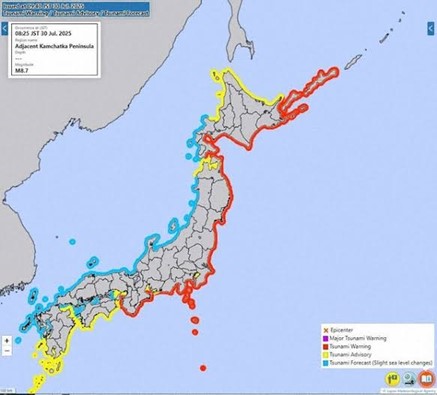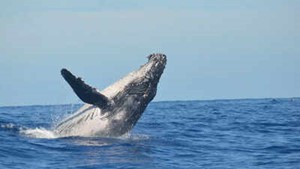A tsunami warning of up to 3 meters has been issued along Japan’s Pacific coastline, stretching from Hokkaido in the north to Wakayama in the south. The warning follows a powerful undersea earthquake that struck east of Russia’s Kamchatka Peninsula earlier today.
According to the Japan Meteorological Agency (JMA), the quake occurred at approximately 6:45 a.m. JST and registered a preliminary magnitude of 8.3 on the Richter scale. Its epicenter was located in the northwest Pacific Ocean, roughly 200 kilometers east of Kamchatka, at a depth of around 40 kilometers. The tremor was strong enough to be felt in parts of eastern Hokkaido and northern Tohoku.
Coastal Residents Urged to Evacuate Immediately
Authorities have urged residents in affected coastal areas to evacuate to higher ground immediately. The JMA warns that the first waves could reach Japan’s northern shores within hours and may increase in strength over time.
“Tsunami waves of up to 3 meters are expected to hit coastal areas. Please do not go near the ocean. Residents in low-lying zones must seek safety in elevated areas,” said an official from the JMA during an emergency press briefing.
Local governments in Hokkaido, Aomori, Iwate, Miyagi, Fukushima, Ibaraki, Chiba, Tokyo, Kanagawa, Shizuoka, Mie, and Wakayama have activated emergency response measures. Schools and transportation services in many of these areas have been temporarily suspended. Bullet trains operating in the Tohoku and Hokkaido regions are running with delays or have been halted as a precaution.
International Monitoring
The Pacific Tsunami Warning Center (PTWC) in Hawaii has also issued alerts for parts of the Pacific Rim, including the western coast of North America and several Pacific Island nations. However, the most immediate threat remains to Japan due to its proximity and geographic vulnerability.
Russia’s emergency services reported that coastal communities on the Kamchatka Peninsula have also been evacuated, though no immediate damage or casualties have been reported.
Seismic History and Preparedness
Japan lies in a seismically active zone known as the Pacific Ring of Fire and is well-prepared for earthquakes and tsunamis. However, memories of the devastating 2011 Tōhoku earthquake and tsunami—which killed over 18,000 people—remain fresh in public memory, prompting swift and widespread compliance with emergency instructions.
The Japanese government has emphasized that while tsunami waves may vary in size depending on local topography, even waves below 1 meter can be dangerous. All individuals in affected areas are being advised to avoid rivers, harbors, and beaches until the warning is lifted.
Next Steps
The JMA continues to monitor the situation closely and will provide updates every 30 minutes or as necessary. Prime Minister Fumio Kishida has convened an emergency disaster response meeting and assured the public that all necessary measures are being taken to safeguard lives and infrastructure.
As of now, there have been no reports of major injuries or structural damage, but authorities remain on high alert.
If You Are in an Affected Area:
- Evacuate immediately if advised.
- Follow instructions from local authorities.
- Stay away from the coast until all-clear is announced.
Source:https://www3.nhk.or.jp/nhkworld/en/news/realtime/















